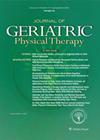APTA Geriatrics' Guiding Principles for Best Practices in Geriatric Physical Therapy: An Executive Summary.
IF 1.5
4区 医学
Q4 GERIATRICS & GERONTOLOGY
引用次数: 1
Abstract
Geriatric physical therapy requires a unique skill set and knowledge to provide best practice care. The skill set requires clinicians to recognize the significance of the continuum of aging from optimal to pathology-influenced aging and how psychosocial, environmental, behavioral, accessibility, and economic factors affect this aging continuum, optimal health, and wellness. Employing this distinctive skill set while also utilizing evidence-based practice, acknowledging the variability observed in older adults, and utilizing interwoven care systems that impact outcomes are key characteristics of best practice. The Academy of Geriatric Physical Therapy developed best practice guidelines consisting of 6 principles needed to ensure patients receive the care that they deserve. Best practice principles include person-centered care, anti-ageist beliefs, holistic assessment using sound outcome measures, evidence-based interventions, physical activity promotion, and interprofessional collaborative practice. This executive summary presents these principles along with suggested action steps for each element of best practice. The aims are to encourage individual self-assessment, promote improvement in practice on an individual and facility/system level, increase communication and collaboration with other health care providers about global best practices for older adults, and to further target education, resources, and advocacy toward achieving best practice on a larger scale.美国老年医学协会老年医学指导原则的最佳实践在老年物理治疗:执行摘要。
老年物理治疗需要独特的技能和知识来提供最佳实践护理。该技能要求临床医生认识到从最佳到病理影响的衰老的连续性的重要性,以及心理社会、环境、行为、可及性和经济因素如何影响这种衰老连续性、最佳健康和身心健康。采用这种独特的技能,同时利用循证实践,承认在老年人中观察到的可变性,以及利用影响结果的交织护理系统,是最佳实践的关键特征。老年物理治疗学会制定了最佳实践指南,其中包括确保患者得到应有护理所需的6项原则。最佳实践原则包括以人为中心的护理、反年龄歧视信念、使用合理结果衡量标准的整体评估、循证干预、体育活动促进和跨专业合作实践。本执行摘要介绍了这些原则以及最佳做法各要素的建议行动步骤。其目的是鼓励个人自我评估,促进个人和机构/系统层面的实践改进,加强与其他医疗保健提供者就全球老年人最佳实践的沟通和合作,并进一步将教育、资源和宣传目标定为实现更大范围的最佳实践。
本文章由计算机程序翻译,如有差异,请以英文原文为准。
求助全文
约1分钟内获得全文
求助全文
来源期刊

Journal of Geriatric Physical Therapy
GERIATRICS & GERONTOLOGY-REHABILITATION
CiteScore
3.70
自引率
4.20%
发文量
58
审稿时长
>12 weeks
期刊介绍:
Journal of Geriatric Physical Therapy is the leading source of clinically applicable evidence for achieving optimal health, wellness, mobility, and physical function across the continuum of health status for the aging adult.
The mission of the Academy of Geriatric Physical Therapy is building a community that advances the profession of physical therapy to optimize the experience of aging.
 求助内容:
求助内容: 应助结果提醒方式:
应助结果提醒方式:


